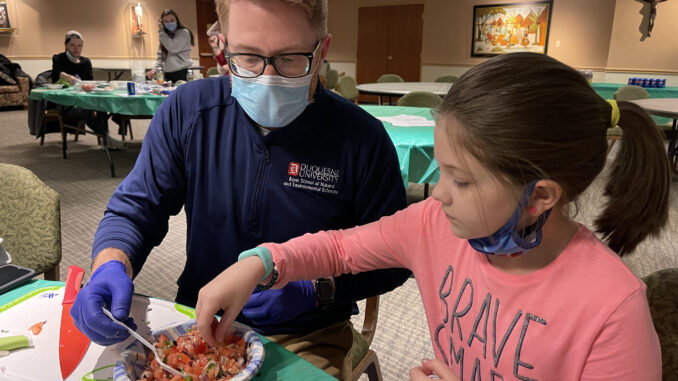
by Emma Polen | features editor
March 3, 2022
Students learned the chemistry behind salsa’s deliciousness with the Duquesne University American Chemical Society (ACS) last Friday in the Africa Room.
ACS hosted their first ever Iron Chef event, called “Fe Chef” for iron’s atomic symbol. Attendees had the opportunity to learn the chemical science behind salsa, and then try their hand at making the spicy snack themselves.
The event began with a presentation delivered by Arian Hajihassani, freshman biochemistry major.
While listening to Hajihassani explain the chemistry of salsa, participants had the chance to sample chemistry professor and ACS advisor Dr. Paul Lummis’ homemade salsas. Attendees tried salsa verde, a green salsa made with roasted tomatillos instead of tomatoes and a salsa de arbol, which is a tomato based salsa with arbol chiles.
The spicy element of salsa is called capsaicin, a molecule in peppers and other favorite spicy ingredients.
Capsaicin is a nonpolar molecule, meaning it is hydrophobic and not easily soluble in water. This is why drinking water doesn’t help with the burn when eating spicy foods. Hajihassani also warned against washing hands with water after handling a pepper.
“Try hand sanitizer,” he said. “The chemical compound of hand sanitizer will be more successful in removing all traces of capsaicin from hands (so as not to accidentally burn your eye).”
Capsaicin is soluble in lipids, so milk is a reliable way to relieve the burn after eating peppers. Chemical components are also what make garlic aromatic and tomatoes vibrantly red.
Food scraps are another way that chemistry comes into play when making salsa. “Composting is a chemistry about the break down of food,” said Hannah Lasko, President of Duquesne ACS and a senior chemistry major.
According to Hajihassani, 1.4 billion tons of food get wasted every day in the world. Food waste is a major problem in the U.S. alone.
For this reason, ACS was sure to include composting as a component of Iron Chef.
At each table was a CarbonCompost bin in which participants could place their food scraps as they prepared their salsa.
The CarbonCompost bins were collected and delivered to their Pittsburgh location.
Under the direction of Lummis, attendees sharpened their skills with cutting tips and reminders about how to handle the most pungent of the ingredients, like putting gloves on before preparing the jalapeno pepper.
Tamara Sioui, a sophomore public health major, has made salsa before. It’s been a while, though, she said.
“Being in a dorm, I don’t get to cook. It was a nice change of pace,” Sioui said.
Kaylyn Mackey, a sophomore occupational therapy major, was making salsa for the first time at Iron Chef. She enjoyed the experience, especially because she was the winner of a knife block raffle at the end of the event.
Lasko was satisfied with the outcome of Iron Chef. She hoped others, like her, had gained some practical skills from the experience as well.
“I learned how to actually use a knife,” she said.
Lasko attributed the idea for Iron Chef to Serina Tressler, the next president of ACS.
Tressler was also happy with the results of the event in the Africa Room, and she hopes to put the event on again in the future.
In the spirit of food waste reduction, all participants were encouraged to take their leftover salsa home in reusable containers, provided by ACS. In addition, they were supplied with locally-made tortilla chips from Reyna Foods, a Central and South American food shop in the Strip District, to complement their sustainable salsa.



